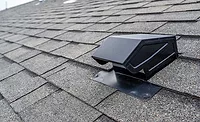Hold Your Ground with Homeowners

It wasn’t until the fourth roofing contractor arrived at the house that the homeowner heard about the importance of attic ventilation for the new roof that was being estimated. That fourth contractor submitted the highest price for the project.
The homeowner hired that fourth contractor.
That fourth contractor was Andy Matyszewski, owner of ABM Roofing in McDonough, Ga. In a recent podcast interview, Matyszewski shared how he holds his ground with homeowners regarding a project’s scope of work and his fair asking price.
Two very common complaints or points of frustration expressed by roofing contractors during the Q&A portion of our seminars are this:
“I have to compete against roofing contractors who never mention proper attic ventilation to the homeowner. And, as a result, my price is almost always higher than the other estimates. So now I have to explain something the homeowner has never heard before — attic ventilation — and I have to defend my price.”
Matyszewski understands why it happens.
“Unfortunately, many contractors do not take the time to educate themselves about the total roof system including the attic ventilation,” he says. “I have to admit I was one of those guys until I attended the seminar. But now that I understand, I use that knowledge to my advantage.”
Bring Clarity to the Conversation
By taking the time to explain to the homeowner the need for attic ventilation, Matyszewski says he’s able to bring clarity to the project.
“Their roofing project becomes more about quality and less about price alone. That becomes a huge advantage for me. It’s all about educating the homeowner about the entire roofing system — not just the shingles, not just the attic ventilation — but the entire project,” he says.
Matyszewski says he arrives to each homeowner meeting expecting to explain the roof system.
“It’s always on my mind as I’m arriving. 'Where do I start? What’s the most important part of the roof system to the homeowner? How do I bring up the other important elements of the roof system?' I try to educate the homeowner step-by-step, highlighting the importance of everything along the way,” he says.
Specific to attic ventilation, Matyszewski walks each homeowner though the need for the roof to have intake vents and exhaust vents in a specific quantity based on the attic’s square footage. The intake vents, installed low on the roof or in the soffit/overhang of the house, allow air into the attic pushing out any heat and moisture buildup inside the attic through the exhaust vents installed at or near the roof’s peak.
He offered the following advice for fellow roofing contractors frustrated that they have to bid against other roofing companies not discussing attic ventilation:
“Embrace it. Educate yourself. Be confident. And use that knowledge to sell the products needed for the roof system,” he says. “My approach is to educate myself first. Then I educate the homeowner. I have confidence explaining the products and services I’m offering to the homeowner.”
Use the Attic to Grab Attention
To help ease the suspicious homeowner wondering why Matyszewski is the only contractor mentioning attic ventilation, he asks for access to the attic.
“I always ask if I can go into the attic and that alone gets us talking further because very few contractors mention going into the attic,” he says.
His attic inspection then gives him the opportunity to discuss if the intake vents are blocked by anything in the attic and where the bathroom fan ductwork terminates (hopefully safely to the outdoors to remove the water vapor). Inside the attic, he can confirm that the exhaust vents indeed have holes through the roof deck.
“The attic is an excellent starting point to bring up the importance of attic ventilation,” Matyszewski says. “I strongly recommend that other roofing contractors do this and that homeowners familiarize themselves with the topic, too. The goal is to bring it all together so the homeowner can grasp the full value of the entire roof system.”
When the inevitable discussion about price comparisons surfaces, Matyszewski politely asks the homeowner to be sure it’s an apples-to-apples comparison — including the cost to install a proper attic ventilation system or bring the current attic ventilation up to par.
“While I do this I am explaining the value in spending a little extra to get much better end results — from the shingles, to the attic ventilation, and all of the various roofing accessories,” Matyszewski says. “My goal is to raise the standard for the entire roof system. In doing this, most homeowners understand I am a step above and will not be the cheapest quote.”
“Embrace it. Educate yourself. Be confident. And use that knowledge to sell the products needed for the roof system. My approach is to educate myself first. Then I educate the homeowner. I have confidence explaining the products and services I’m offering to the homeowner.”
Scope of Work Disagreements
There may be times the homeowner disagrees with the scope of work for the project. The homeowner may question the roofing contractor’s recommendation to fix a current attic ventilation mistake. It’s happened to Matyszewski.
He had a homeowner customer who was a builder who designed and built his own house. Unfortunately, the homeowner/builder committed the very common mistake of mixed types of attic exhaust vents. Mixing exhaust can short-circuit the airflow — can cause inefficient airflow in the attic — as well as weather infiltration through one of the exhaust vent types.
“We looked at the roof together and when I pointed out that too many vent types is like a Christmas tree with too many ornaments, it opened the discussion that more is not always better,” Matyszewski says. “I went into more detail explaining that proper airflow in the attic moves from low to high; detailing that mixing types short-circuits that proper flow. I emphasized that the airflow must be properly balanced with intake and exhaust without combining exhaust types. That caught his attention. He started to realize I was making sense and knew what I was talking about.”
Use Visuals
It helps to visually point out for the homeowner the issues that are potentially concerning with the roof. As Matyszewski points out, though, it’s all about attitude.
“Be confident but also kind,” says Matyszewski. “Help the homeowner understand the entire roof system. Once you put that into context for the homeowner, it makes the sale and the whole process so much easier. It really comes down to being confident and having a positive attitude while explaining the entire roof system to the homeowner. It makes the homeowner more comfortable with the project, understanding the plan, and the homeowner trusts you and your recommendation. That helps you break through any barriers with the homeowner and establish a good relationship.”
To enhance his conversations with homeowners about attic ventilation, Matyszewski keeps a sample piece of ridge vent handy (90% of his roofing projects involve ridge vent as the exhaust vent system).
“I let the homeowner touch it, bend it, and hold it. Once they physically see it and feel it, it sparks more interest in the product and the overall concept of attic ventilation,” he says. “This helps me further stand out from other contractors who never mention attic ventilation. Carrying a sample ridge vent has been a very beneficial piece in my presentation to homeowners.”
Looking for a reprint of this article?
From high-res PDFs to custom plaques, order your copy today!



.webp?height=200&t=1628274832&width=200)


